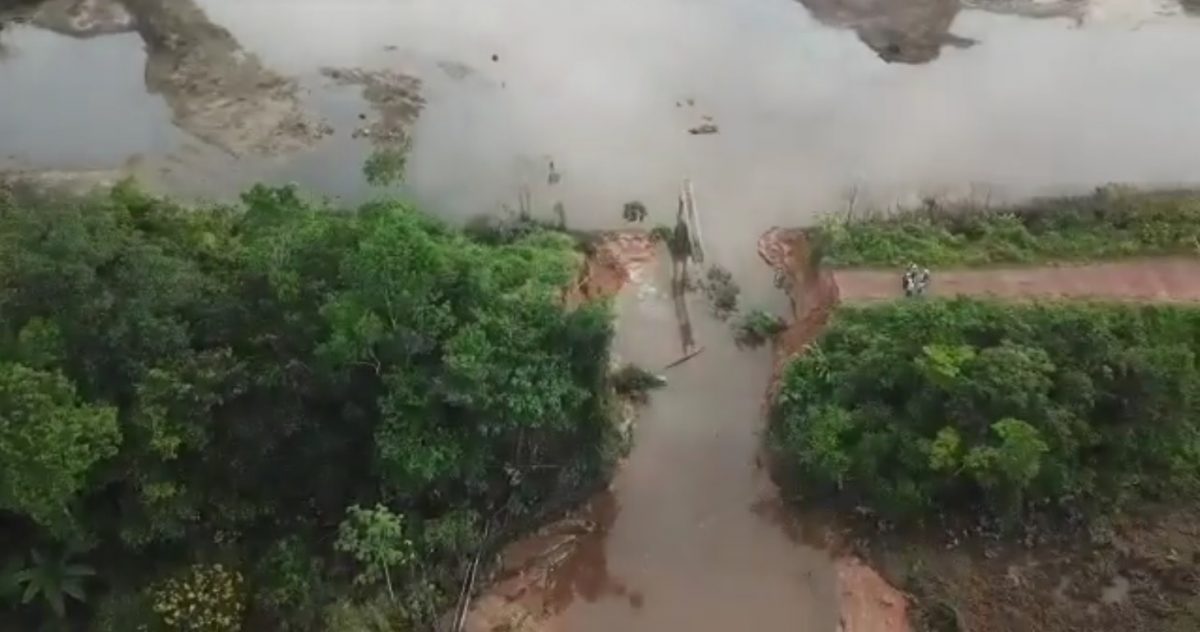A compromised drainage system is suspected to be the primary cause of the recent flash flooding in Matthews Ridge, Region One, after the reservoir belonging to Chinese-owned Guyana Manganese Inc (GMI) collapsed, Regional Chairman Brentnol Ashley said yesterday.
Ashley said that from all indications the company did not change drainage pipes that were laid years ago. The integrity of the pipes, he said, is believed to have been compromised by the volume of water in the reservoir.
“The reservoir has three pipes underground that is used for draining the water out but it appears as if those pipes were compromised and undermined and that resulted in the flooding,” he said.
Questioned on whether the reservoir is community-owned and the criteria used for allowing the company to utilise it, Ashley responded in the negative.
“The pond has been a part of the concession area. It was used by the … Manganese Company years ago but when they left the community used it. When GMI started operations they took back the pond and placed tanks with water for the community to use,” he noted.
Ashley said the flooding was unfortunate but efforts are being made to remedy every situation that developed following the floods.
Since the flooding, Ashley said the community has been visited by investigators from the Guyana Geology and Mines Commission (GGMC) and the Environmental Protection Agency (EPA), who conducted assessments. No statement has been made by GMI or GGMC on the matter, the EPA posted a one-paragraph statement on its Facebook page.
The Regional Chairman noted that it is still unclear if the environment was impacted by any release of chemicals into the community due to the flooding and it will have to await the findings from the authorities.
At the time of the flooding, GMI was producing manganese on a small scale and several employees were on duty. The flash flooding from last Thursday forced at least seven families to move to higher grounds. Two homes were completed flooded by the water that escaped from the reservoir and a family had to seek support from trees as the force of the floodwater was extremely strong.
“It happened very suddenly. We had to think fast but we can swim so we held on to the trees to help us,” an affected resident told this newspaper last Thursday via phone. Her family was eventually rescued from the trees by GMI employees.
Reconstruction
Meanwhile, Ashley yesterday said that the company is currently engaged in the reconstruction of a washed away section of the road, since the community was cut off from other areas.
He stated that work commenced Friday last and the company is still rebuilding and upgrading the road which connects to Port Kaituma.
The collapsed reservoir washed away about 20 feet of the public road, isolating the community and flooding several farms and homes. A temporary path was constructed to allow vehicular traffic to flow.
Community Councillor Noreen Bess yesterday told Stabroek News that the community is still awaiting an explanation from the company as to what transpired.
“We don’t have an understanding of what happened. We had hoped the company will come and meet with the community and said this happened but the RC (Regional Chairman) said the region will do that but nothing has been done since,” she lamented yesterday.
Subsequent to the flooding, GMI assisted the families by distributing food hampers and in one case compensated an elderly man whose clothes were washed away. He was given $30,000.
The EPA, the only government agency that has spoken on the matter, in a brief statement, said that it was notified of the breached reservoir at GMI’s Matthews Ridge operation. An emergency team was dispatched to the area to assess the situation and it was determined that there was no immediate environmental threat.
A resident, Jamil Changlee, in a letter penned to this newspaper in August, had alleged that the company had not been practising safe mining techniques. He noted that the health risks of the manganese mining venture in Matthews Ridge continued to outweigh the value to be obtained.
“We are already hearing of, and seeing the gross mishandling of mining operations resulting in damage to the environment and infrastructure,” he said, pointing out that financial contribution to the community is a minuscule amount and far from sufficient to compensate for the human and environmental harm that manganese mining brings to Matthews Ridge.
“Our people are our most important and valuable resource. We must provide leadership that will ensure that their needs, health and safety comes first and foremost when investment decisions are being made,” he stated further.
GMI had its Environmental Impact Assessment (EIA) for the Region One project approved by the Environmental Protection Agency (EPA) in May of this year.
The mine was closed in March of 2019 when workers carrying out scoping works took ill and two – 47-year-old Zhenglong Zong, and 45-year-old Zengguo Ji, both Chinese nationals – subsequently died from what the company said was leptospirosis and respiratory failure
After the two workers succumbed, the Chinese government made a request for the 10 sick workers – all Chinese nationals – to be flown back home for medical attention. This request was granted and the men were flown back to their home country.





